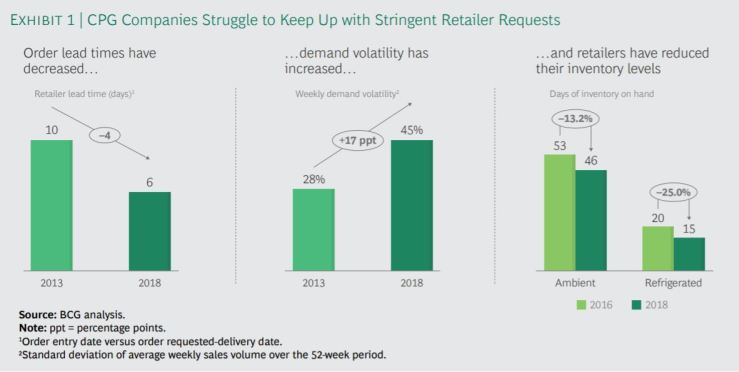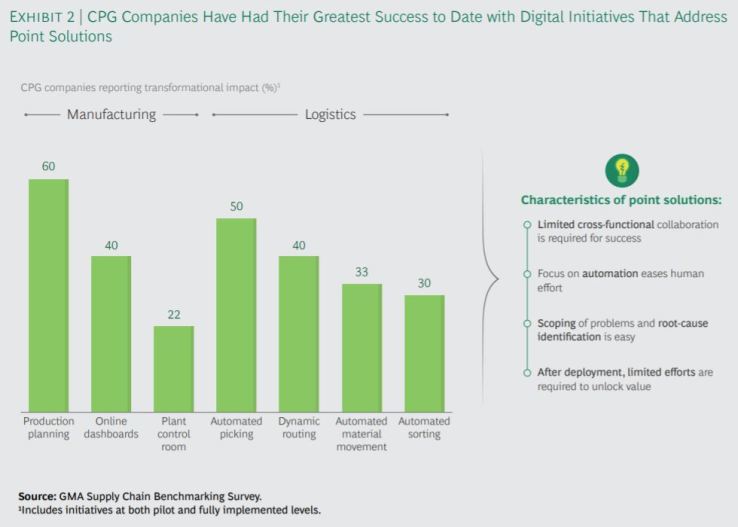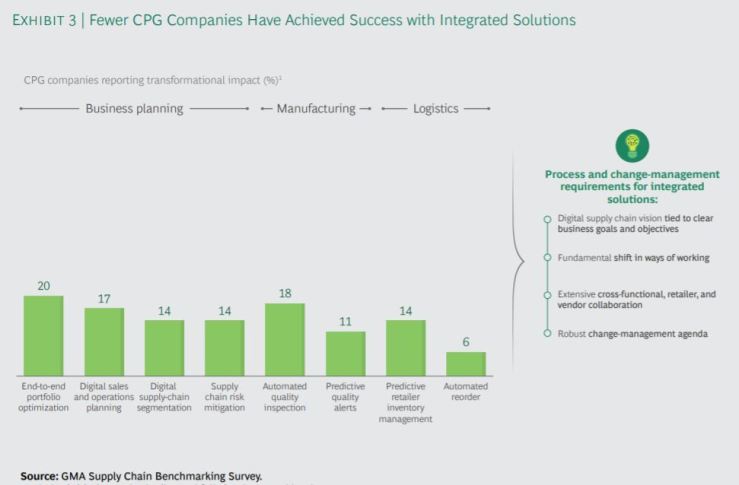Consumer packaged goods (CPG) are feeling tremendous pressure in 2019. Increased demand volatility and shorter lead times from retailers have become major concerns, hurting service and inventory levels. Under Pressure, CPG supply chains look to digital.
Although CPG companies have not historically operated at the forefront of digital change, the intense and competing demands they face today require exactly the type of game-changing approaches that digital can deliver.
What’s Worrying Supply Chain Leaders
Leading North American CPG companies have spent the past few years focusing on the bottom line. They have done so with good success, increasing operating margins from 16.8% in 2014 to 20.7% in 2017. This year, however, growth has become much more prominent on the priority list. This puts greater pressure on the supply chain, reflecting the highlighted issues in service levels, inventory, and trucking capacity.
Service and Inventory Levels
Recently, CPGs have been worried about their ability to keep service levels high and reduce their days of inventory on hand (DIOH). And our 2019 survey validates these concerns, as service levels have indeed taken a downward turn, while inventory has increased. On the service side, for example, median on-time delivery fell to 87.1%, a drop of 2.7 percentage points, from 2016 to 2018. On the inventory side, the average DIOH for finished goods increased from 35 to 37 for ambient goods. And from 13 to 17 for refrigerated goods over the same period. (See Exhibit below)

CPG companies are finding it much harder to forecast demand and stock the right inventory at the right location. In addition, retailers are actively reducing their own inventory levels but putting pressure on their CPG suppliers to hold more. This allows them to restock their shelves quickly and keep orders flowing.
To combat these pressures, CPG players are improving their forecasting algorithms and capabilities. From 2016 to 2018, the national two-month mean absolute error improved by 5 percentage points from 32% to 27%.
Yet accurate demand forecasting and effective demand planning remain a challenge. Many of the CPG companies that we interviewed believe that they’ve reached the limits of what they can achieve alone. Further improvements will require downstream collaboration with retailers. Others are exploring the potential to improve demand forecasting, inventory, and optimize costs by investing in digital initiatives.
Prioritizing Digital Transformation
As digital technologies steadily become cheaper and more effective, the case for digital supply chain becomes increasingly compelling. According to a BCG–Google study, supply-chain use cases are among the highest-impact AI applications for CPG. Improved demand forecasting in the supply chain, for example, offers potential sales growth of at least 2.5%, while the ability to individualize store assortments—analyzing sales data at the SKU level and redesigning the supply chain to prioritize those SKUs—permits sales growth of at least 1% to 2%.
We therefore asked our respondents this year about the active steps they are taking with respect to their digital supply-chain goals.
We found that 21% have a vision for the digital supply chain and 58% are working toward such a vision. Also, approximately 26% of the CPG companies we surveyed said that “digital in the supply chain” is a top priority for the business, and about half reported piloting 15 or more digital use cases. They have launched these pilots across the spectrum of manufacturing and logistics, to achieve objectives ranging from production planning and dynamic routing to automated quality inspection and predictive retailer inventory management.
So far, supply chain leaders have had the greatest success with simple plug-and-play solutions for specific supply-chain issues. (See Exhibit below). For example, on the shop floor, these solutions include digital production planning and online dashboards. In warehousing and logistics, they include automated picking and dynamic routing. Such point solutions tend to be relatively straightforward to implement. They require relatively little cross-functional coordination, and are generally limited in scope to one area of the supply chain.

In contrast, respondents report achieving far less success from investments intended to solve multifaceted supply-chain problems. Investments that require extensive cross-functional coordination and substantial change to core business and supply chain processes. (See Exhibit below )

How to Scale Digital
As CPGs look to digital and launch pilots, many have been less successful than the companies had hoped. Almost 50% have had little or no impact, and 34% have had only incremental impact.
Why have they failed? Our survey participants told us that achieving the full benefit of digital requires more than the latest technology. It requires successful change management, the elimination of functional silos, and strong technical capabilities. In our experience, only about 30% of the full value of digital comes from the algorithms and IT.
The remaining 70% comes from business transformation. And when companies don’t clearly link the vision for this transformation to their strategic needs, the effort tends to stall. Such complex changes also require an unwavering commitment to the transformation, a fundamental shift in ways of working, and a robust change-management program.
CPGs looking to digital need to elevate and accelerate the transformation of the supply chain as a C-suite priority, setting clear goals tied directly to key business issues.
The above is an abbreviated version of our article “Under Pressure, CPG Look to Digital” in collaboration with GMA. Read full length article here
